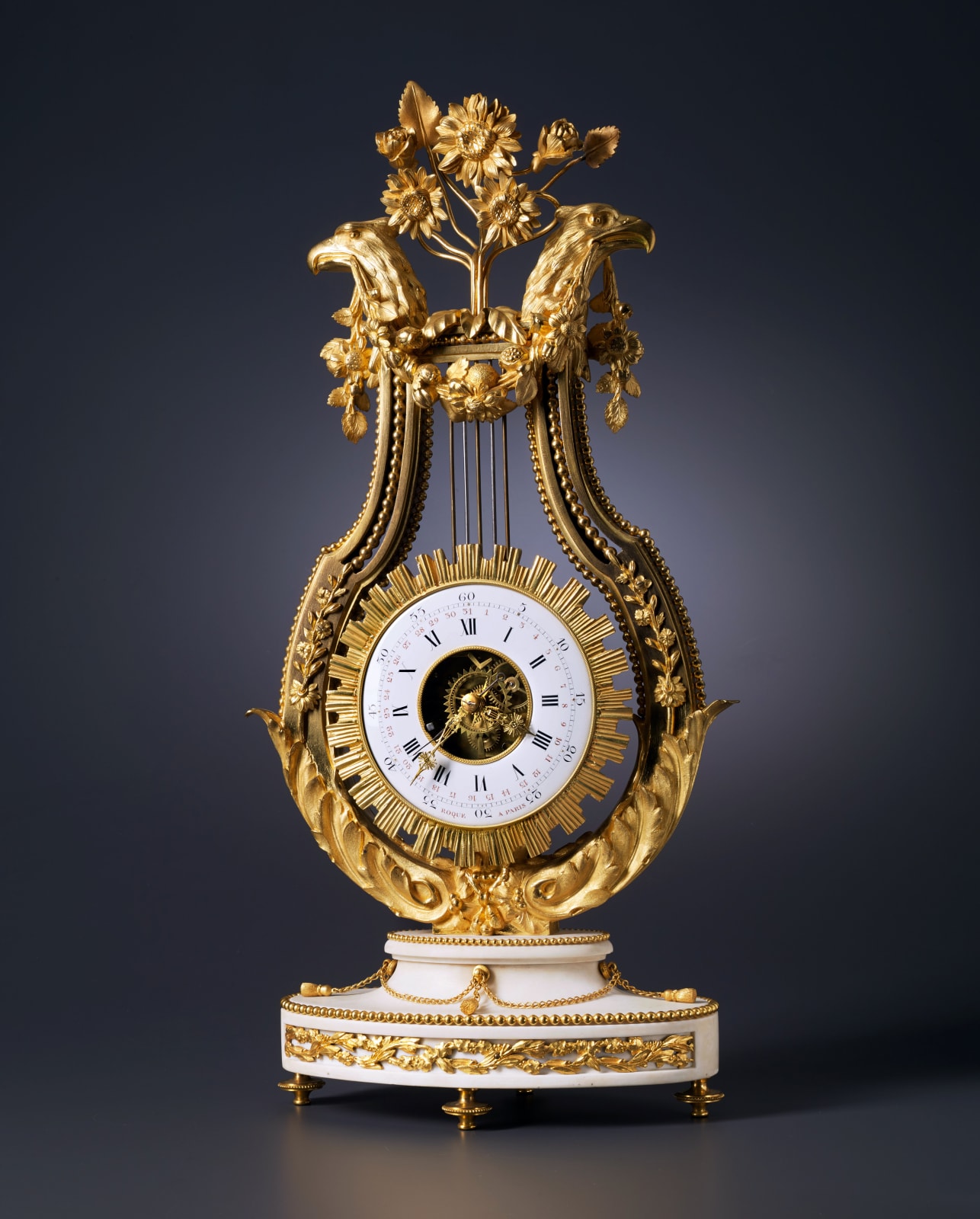Jean Léonard Roque
Literature
Hans Ottomeyer and Peter Pröschel, “Vergoldete Bronzen”, 1986, p. 252, pl. 4.6.25, illustrating a skeletonised lyre clock housed in a comparable case, signed on the dial Manière à Paris, housed at Château de Versailles. Tardy, “Les Plus Belles Pendules Françaises”, 1994, p. 83, illustrating two similar clocks, both with skeletonised dials of which one in the Musée des Arts Décoratifs, Paris is fitted with a movement by Louis-Michel Harel. Pierre Kjellberg, “Encyclopédie de la Pendule Française du Moyen Age au XXe Siècle”, 1997, p. 225, illustrating another very similar clock, with movement by Gaston Jolly. J. O. Scherer, “Antike Uhren”, pl. XV. Elke Niehüser, “Die Französische Bronzeuhr”, 1997, pp. 260-61, pls. 1242-46, illustrating similar lyre clocks, of which the closest is pl. 1246 – originally illustrated in Ernest Dumonthier “Les Bronzes du Mobilier National – Pendules et Cartels”.
A very elegant and important Louis XVI gilt bronze and white marble skeleton lyre clock by Jean Léonard Roque of eight day duration, signed on the white enamel dial Roque à Paris, the dial with outer Arabic numerals for the minutes, the inner ring with Roman numerals for the hours and central ring with red Arabic numerals for the 31 days of the month, with a very fine pair of pierced gilt brass hands, each with a sunburst pointer, for the hours and minutes and also with a blued steel hand for the calendar indications. The free-swinging dial, acting as the clock’s pendulum, with a sunburst bezel and cut out centre to reveal the skeletonised movement with silk thread escapement, striking on the hour and half hours. Housed in a beautiful part-pierced beaded, floral and foliate lyre-shaped case, the top crowned by a pair of outward facing eagle heads linked by floral and fruiting swags surmounted by a bouquet of sunflowers, on an oval waisted white marble base edged by pearl bands, hung with tasselled chains and the frieze with a pierced foliate mount, on bun feet
Paris, date circa 1785
Height 61 cm, width 27 cm, depth 15 cm.
Examples of this exquisite clock with its lyre-shaped case crowned by eagle heads and sunflowers, can be found in several important public collections, counting among them Château de Versailles and the Musée des Arts Décoratifs, Paris. Similar clocks with almost identical cases and dials bear the signatures of such clockmakers as Schmit, Gavelle le Jeune, Pochon and Harel. The present movement was made by Jean Léonard Roque (d. after 1789), a brilliant mechanic who specialised in the production of complex luxury pieces. Roque’s ingenuity owed much to his early training under the mechanical expert Alexis Magny (1712- d. after 1793) as it did to his subsequent experience as assistant to Claude-Siméon Passemant (1702-69). During that period, Roque made the mechanisms for Passemant’s pair of moving globes (1759; supplied to the marquis de Marigny who offered them to the King). He also made the mechanisms for Passemant’s extraordinary ‘Creation of the World’ clock, housed in a case by François-Thomas Germain (1754, Musée du Château de Versailles). Roque worked for Passemant until the latter’s death in 1769. A few months later he was received as a maître, having already obtained lodgings in the Vieux Louvre within the Colonnades building. He was later in the Passage du Saumon, 1772-89.
After Passemant’s death Roque tended to specialise in the production of complex clocks, some of which incorporated revolving bands including one showing full calendar indications and signs of the zodiac, housed in a case representing Great Britain and Mars in Repose (illustrated in Jean-Dominique Augarde, “Les Ouvriers du Temps”, 1996, p. 237). He also made the movements for a remarkable pair of matching gilt bronze and marble clock and calendar vases, (made for the marquis de Brunoy 1774, now in the Rothschild Collection at Waddesdon Manor, Buckinghamshire). One can also admire his work in the Musée du Louvre and National des Techniques in Paris, Musée Paul Dupuy in Toulouse, the Musée de Bâle, the Hermitage Museum at Saint Petersburg, the Huntingdon Collection at San Marino, California, the Kunstindustrimuseet in Copenhagen and in the Swedish Royal Collections.
As Horloger du Roi, Roque supplied clocks to Louis XV and his daughters Mesdames Victoire and Adelaïde as well as Louis XVI and Marie-Antoinette. He was also patronised by the comte de Provence, the duc de Polignac, the marquis de Brunoy, MM. Beaujon and de Boulogne. All would have delighted in his ingenious mechanisms as well as his fine cases, which were supplied by such brilliant masters as Jean-Joseph de Saint-Germain, François Vion, Jean-Louis Prieur, Nicolas Bonnet, François Rémond and Beaucourt. Despite his illustrious patronage, Roque appears to have gone bankrupt circa 1785-6, but probably through the intervention of the Châtelet and his appointment as pensionnaire du Roi in 1786 he continued working up until the beginning of the Revolution.
